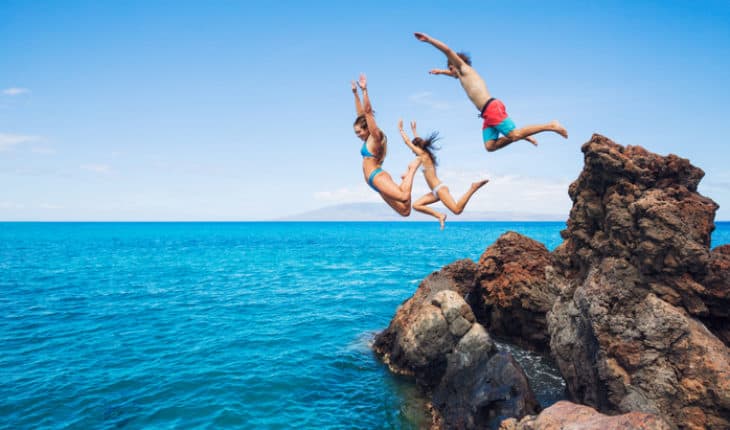Water safety aspects, including drowning and emergency responses are discussed here by First Aid expert Emma Hammett of First Aid For Life.
Covid-19 lockdown is easing, and we welcome the reopening of many non-essential businesses, including some lidos and outdoor swimming pools. Unfortunately, indoor swimming pools however remain closed for just a little bit longer. More people than ever before are looking to explore the great outdoors and to visit the seaside with their families and friends this summer. There has been a strong interest in swimming in the sea or open water. Water comes with risks and sadly drowning can happen quickly and quietly. We offer a guide on how to enjoy swimming safely, be it in a paddling pool, villa pool, river, lake or the sea.
General Dangers of Water
The general dangers of water –according to the RoSPA website – which is crucial to bear in mind, are as follows:
- UK water is usually very cold – and even when abroad, there is often a major contrast between air and sea temperatures.
- there may be hidden currents
- it can be difficult to get out (steep slimy banks)
- it can be deep
- there may be hidden rubbish and hazards, e.g. shopping trolleys, broken glass, rocks and other debris or weeds that you could get caught in and could drag you under
- there are currently no lifeguards
- it is difficult to estimate depth
- it may make you ill if contains pollution
What to do if you think someone is drowning
- Dial 999.
- You should do everything possible to avoid getting yourself into a dangerous situation – do not be tempted to go in after them
- Throw a buoyancy aid to them, and only go in if you know how to help someone. A drowning and panicking casualty can quickly pull you under.
- If the rescue is too dangerous, wait until the emergency services arrive.
Read our article about first aid for someone who is drowning here
Cold Water Shock
Because of the contrast in air and water temperature, many people who fall into/swim in the sea, canal or lake are at high risk of suffering cold water shock.
Cold water shock causes you to gasp uncontrollably and panic, which often leads to drowning. The shock of entering the water triggers the automatic fight or flight response resulting in panic and confusion, putting additional strain on the heart, further lowering skin temperature by shutting down the peripheral circulation. Thrashing around trying to swim will encourage air to escape from clothing, thereby reducing buoyancy and making it harder to float.
It doesn’t matter how strong a swimmer you are, anyone can succumb to cold water shock.
The RNLI Respect The Water Campaign urges people to avoid gasping, thrashing or swimming hard and to remain as calm as possible, turn onto their back and float instead.
Floating
Floating offers an opportunity to catch your breath; allowing the effects of cold water shock to pass. This should take no more than about 90 seconds. Do not worry if you are wearing clothes and shoes as these will remain buoyant and help you to float in the initial minute it takes you to regain control of your breathing.
Once you have control of your breath, you can swim to safety, call for help or continue to float until help arrives.
Understanding this approach and floating rather than panicking will greatly increase your chances of survival.
Control Your Breathing
The key message is to do as little as possible until you can control your breathing.
The RNLI are urging people to practise floating and share this important message as it has been proven to save lives.
Five steps to float:
- Fight your instinct to thrash around
- Lean back, extend your arms and legs
- If you need to, gently move them around to help you float
- Float until you can control your breathing
- Only then, call for help or try swim to safety
The RNLI also advises if you see someone in difficulties in the water to fight the urge to go in and try and rescue them. Instead call 999 and ask for the Coastguard. Or call 112.
It is worth remembering too, that the sudden and extreme contrast between warm air and cold water, can lead to cardiac arrest. Consequently, it is strongly advised not to jump or dive straight into cold water on a hot day.
Children and water
Supervision is key
Children should always be supervised in the water. Although it’s tempting to think that they will be safe if they’re wearing a rubber ring or armbands – you should never rely on a buoyancy aid or inflatable. In fact, inflatables can sometimes be more dangerous as if they tip, children can struggle to right themselves and they can be left submerged. Always ensure you are in the water, within reaching distance. However, it’s not just in swimming pools, lakes and rivers that children require supervision. You should never leave them on their own in baths or paddling pools and always supervise with any water play.
Be Aware
Whatever your age, staying vigilant around water is crucial as drowning can happen quickly and surprisingly quietly and causes a frightening number of fatalities every year.
Pools and paddling pools

Most swimming pools have various depths and it can be easy to misjudge where the shallow end stops and the deep end suddenly starts, especially in private pools that don’t have clear markings. Ensure you know the pool depths before your children jump in for the first time (in case it’s too deep or too shallow). Drowning can happen extremely quickly and usually silently, without any obvious signs of a struggle. Furthermore, a child can drown in just 2 cm of water, which is barely deeper than some puddles and considerably shallower than the average paddling pool.
Water seems to have an endless fascination for small children, they can be drawn to it and can very quickly find themselves in danger.
Lifesaving lessons
So – to make your most of your time in the water, start teaching your children to recognise and observe water safety signs such as no diving, no swimming or deep water as early as possible. Also, teach them to always follow the guidance provided by lifeguards and indicated by flags to show where it is safe at the beach. These basic lessons can be real life savers.
When on holiday:
- Check the safety arrangements at the property in advance and choose pools with a fence and locking gates.
- Check the property when you arrive to ensure there are no ponds and that the pool really is secure for your child.
- Always supervise children when they are playing in or near water and be sober.
- Teach children to swim from an early age
- Speak to your children about staying safe in ponds, lakes, rivers and seas and always deter them from diving into any unknown depths.
Water safety guidelines for adults, teenagers and older children
Adventure Water Sports
Adventurous water sports such as kayaking, white-water rafting or surfing are increasingly popular during the summer break. Riskier activities such as diving into the sea from cliffs or tombstoning often happen in the holidays and frequently with teenagers on that post-exam holiday.
Tombstoning
Tombstoning is when someone plunges into deep water from a bridge, cliff or quay, is a high-risk activity. It has resulted in fatalities or injuries, such a spinal and limb injuries. Diving off cliffs is extremely popular and sadly results in a large number of people experiencing life-changing injuries from spinal injury.
Encouraging your children to undertake a first aid course can make them far more risk aware and more sensible and cautious when approaching these dangerous activities.
Click here to learn more about first aid for a suspected spinal injury.
These injuries happen because people misjudge the depth of the water they are jumping into and it is shallower than it looks. Or they are unable to see submerged objects such as rocks.
Cliff Diving
Jumping and diving from cliffs is a popular past time for many teenagers. This is dangerous, however tempting! Locals will know currents, underwater obstacles and underwater terrain better than visitors. Even they will often find themselves in difficulties. Sadly, it is an extremely common cause of admission to emergency units with a broken neck, or life-changing injury.
Alcohol and drugs alter perception, reduce inhibitions and increase risk taking. I was horrified on holiday last year at the number of teenagers, obviously intoxicated, who were encouraged by crowds to dive off high cliff tops into dark waters beneath. They had no way at all of gauging possible dangers beneath.
Currents
Difficulties can also occur as people underestimate the strength of the current or their ability to get out of the water because of steep rocks or a slimy riverbank.
Two of my sisters very nearly drowned when swimming out to what looked like a nearby sandbank. There were incredibly strong currents which made it impossible for them to swim back and they were minutes from drowning when the RNLI got to them – sitting on the beach we could see them and were waving to them, totally oblivious to the danger they were in.
Open Water
Every year people die in lakes, rivers and reservoirs as swimming in open waters is extremely dangerous without proper training, kit and supervision. Open water is cold, it can be difficult to find an easy place to get out of the water and there are hidden dangers such as weeds and debris beneath the surface that you can easily get caught up in and can pull you under.
Party Time
Summer is also a traditional time for teenagers to celebrate the end of their exams, to go on holiday or party with friends. Teenagers are risk takers and in a group, are prone to egg each other on. Both my children and their friends regularly attend our first aid courses, to ensure they are equipped with the skills to recognise if there is something seriously wrong and be able to help themselves or their friends should they have a medical emergency. Speak with your children about the risks of alcohol and taking other substances – particularly when swimming.
It is important that you can look after yourself and your family when by the seaside. We offer tailored first aid courses covering the above topics to empower you with the skills to keep you safe when swimming.
- What is a seizure? - 13th March 2025
- Febrile Convulsions and Seizures in Children - 13th March 2025
- Why women are less likely to receive CPR or survive cardiac arrest - 6th March 2025






